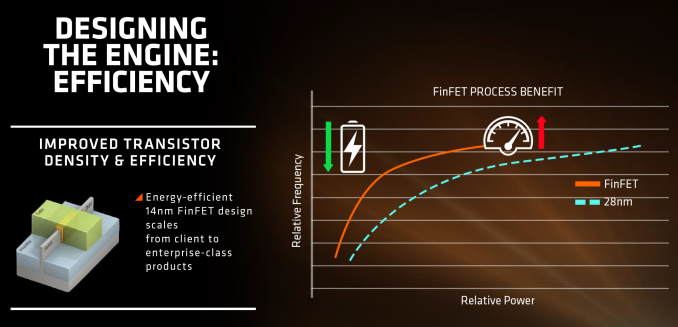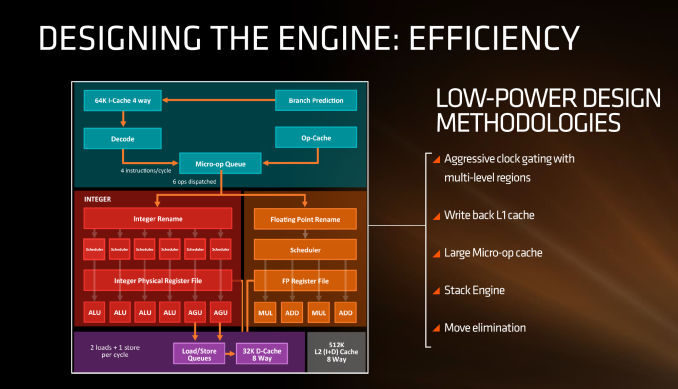AMD Zen Microarchitecture: Dual Schedulers, Micro-Op Cache and Memory Hierarchy Revealed
by Ian Cutress on August 18, 2016 9:00 AM ESTLow Power, FinFET and Clock Gating
When AMD launched Carrizo and Bristol Ridge for notebooks, one of the big stories was how AMD had implemented a number of techniques to improve power consumption and subsequently increase efficiency. A number of those lessons have come through with Zen, as well as a few new aspects in play due to the lithography.
First up is the FinFET effect. Regular readers of AnandTech and those that follow the industry will already be bored to death with FinFET, but the design allows for a lower power version of a transistor at a given frequency. Now of course everyone using FinFET can have a different implementation which gives specific power/performance characteristics, but Zen on the 14nm FinFET process at Global Foundries is already a known quantity with AMD’s Polaris GPUs which are built similarly. The combination of FinFET with the fact that AMD confirmed that they will be using the density-optimised version of 14nm FinFET (which will allow for smaller die sizes and more reasonable efficiency points) also contributes to a shift of either higher performance at the same power or the same performance at lower power.
AMD stated in the brief that power consumption and efficiency was constantly drilled into the engineers, and as explained in previous briefings, there ends up being a tradeoff between performance and efficiency about what can be done for a number of elements of the core (e.g. 1% performance might cost 2% efficiency). For Zen, the micro-op cache will save power by not having to go further out to get instruction data, improved prefetch and a couple of other features such as move elimination will also reduce the work, but AMD also states that cores will be aggressively clock gated to improve efficiency.
We saw with AMD’s 7th Gen APUs that power gating was also a target with that design, especially when remaining at the best efficiency point (given specific performance) is usually the best policy. The way the diagram above is laid out would seem to suggest that different parts of the core could independently be clock gated depending on use (e.g. decode vs FP ports), although we were not able to confirm if this is the case. It also relies on having very quick (1-2 cycle) clock gating implementations, and note that clock gating is different to power-gating, which is harder to implement.












216 Comments
View All Comments
BrokenCrayons - Thursday, August 18, 2016 - link
Hmm...interesting news to say the least, but I'm reluctant to make any assumptions until after Zen is out there being tested. A lot of us were interested in AMD's construction equipment series processors and were disappointed by the final product.Chaser - Thursday, August 18, 2016 - link
Good on AMD! I am hopeful for them with Zen as many others are.ikjadoon - Thursday, August 18, 2016 - link
Hmm....nice timing with IDF. Besides the fantasy of getting XPoint in a consumer drive in 5 years, I agree: most people are more interested in AMD. Cautiously (remember the RX 480 presentation?) optimistic.At the very least, we'll have some competition around the $300 CPU range. Fairly sure the i7-6700K is priced a little too much higher than the i5-6600K.
melgross - Thursday, August 18, 2016 - link
Most people are more interested in AMD? In what way?nandnandnand - Thursday, August 18, 2016 - link
AMD's Zen 4/6/8 cores will be a better value than Intel's i7 quad cores. That's what way.Cygni - Thursday, August 18, 2016 - link
"Will be" sounds pretty definitive considering they aren't even on the market yet and we have no idea how Intel will react with prices or products.You would think people would learn not to over hype products that haven't even come out (see: No Man's Sky) but here we are again...
StrangerGuy - Thursday, August 18, 2016 - link
Yeah, and projected products never gets delayed or meets the hype either.Flunk - Thursday, August 18, 2016 - link
In the competition lowers prices way.ikjadoon - Thursday, August 18, 2016 - link
In the most basic way possible: reading the news, hehe. I think most people (who aren't interested in X-Point) even realize IDF2016 is happening right now, where Intel showed off Kaby Lake silicon inside a Dell laptop running Overwatch.smilingcrow - Thursday, August 18, 2016 - link
"The fantasy of getting XPoint in a consumer drive in 5 years."Firstly, as a replacement purely for NAND in storage most consumers might find it irrelevant.
Secondly, it will be available for consumers but at prices that only prosumers might be interested in.
I think the bigger shift for consumers will be with later products that remove the distinction between memory and storage.